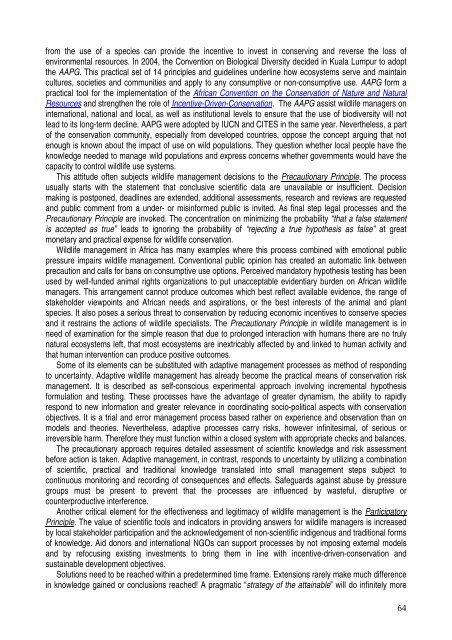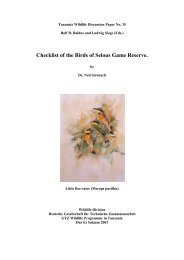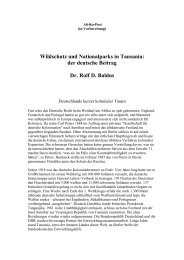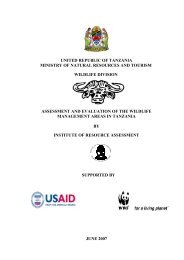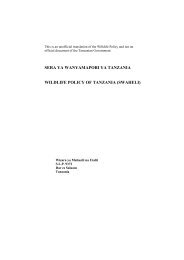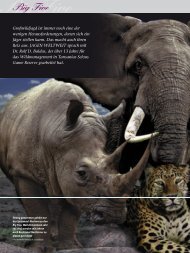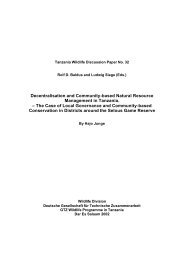African Indaba Articles - wildlife-baldus.com
African Indaba Articles - wildlife-baldus.com
African Indaba Articles - wildlife-baldus.com
Create successful ePaper yourself
Turn your PDF publications into a flip-book with our unique Google optimized e-Paper software.
from the use of a species can provide the incentive to invest in conserving and reverse the loss ofenvironmental resources. In 2004, the Convention on Biological Diversity decided in Kuala Lumpur to adoptthe AAPG. This practical set of 14 principles and guidelines underline how ecosystems serve and maintaincultures, societies and <strong>com</strong>munities and apply to any consumptive or non-consumptive use. AAPG form apractical tool for the implementation of the <strong>African</strong> Convention on the Conservation of Nature and NaturalResources and strengthen the role of Incentive-Driven-Conservation. The AAPG assist <strong>wildlife</strong> managers oninternational, national and local, as well as institutional levels to ensure that the use of biodiversity will notlead to its long-term decline. AAPG were adopted by IUCN and CITES in the same year. Nevertheless, a partof the conservation <strong>com</strong>munity, especially from developed countries, oppose the concept arguing that notenough is known about the impact of use on wild populations. They question whether local people have theknowledge needed to manage wild populations and express concerns whether governments would have thecapacity to control <strong>wildlife</strong> use systems.This attitude often subjects <strong>wildlife</strong> management decisions to the Precautionary Principle. The processusually starts with the statement that conclusive scientific data are unavailable or insufficient. Decisionmaking is postponed, deadlines are extended, additional assessments, research and reviews are requestedand public <strong>com</strong>ment from a under- or misinformed public is invited. As final step legal processes and thePrecautionary Principle are invoked. The concentration on minimizing the probability “that a false statementis accepted as true” leads to ignoring the probability of “rejecting a true hypothesis as false” at greatmonetary and practical expense for <strong>wildlife</strong> conservation.Wildlife management in Africa has many examples where this process <strong>com</strong>bined with emotional publicpressure impairs <strong>wildlife</strong> management. Conventional public opinion has created an automatic link betweenprecaution and calls for bans on consumptive use options. Perceived mandatory hypothesis testing has beenused by well-funded animal rights organizations to put unacceptable evidentiary burden on <strong>African</strong> <strong>wildlife</strong>managers. This arrangement cannot produce out<strong>com</strong>es which best reflect available evidence, the range ofstakeholder viewpoints and <strong>African</strong> needs and aspirations, or the best interests of the animal and plantspecies. It also poses a serious threat to conservation by reducing economic incentives to conserve speciesand it restrains the actions of <strong>wildlife</strong> specialists. The Precautionary Principle in <strong>wildlife</strong> management is inneed of examination for the simple reason that due to prolonged interaction with humans there are no trulynatural ecosystems left, that most ecosystems are inextricably affected by and linked to human activity andthat human intervention can produce positive out<strong>com</strong>es.Some of its elements can be substituted with adaptive management processes as method of respondingto uncertainty. Adaptive <strong>wildlife</strong> management has already be<strong>com</strong>e the practical means of conservation riskmanagement. It is described as self-conscious experimental approach involving incremental hypothesisformulation and testing. These processes have the advantage of greater dynamism, the ability to rapidlyrespond to new information and greater relevance in coordinating socio-political aspects with conservationobjectives. It is a trial and error management process based rather on experience and observation than onmodels and theories. Nevertheless, adaptive processes carry risks, however infinitesimal, of serious orirreversible harm. Therefore they must function within a closed system with appropriate checks and balances.The precautionary approach requires detailed assessment of scientific knowledge and risk assessmentbefore action is taken. Adaptive management, in contrast, responds to uncertainty by utilizing a <strong>com</strong>binationof scientific, practical and traditional knowledge translated into small management steps subject tocontinuous monitoring and recording of consequences and effects. Safeguards against abuse by pressuregroups must be present to prevent that the processes are influenced by wasteful, disruptive orcounterproductive interference.Another critical element for the effectiveness and legitimacy of <strong>wildlife</strong> management is the ParticipatoryPrinciple. The value of scientific tools and indicators in providing answers for <strong>wildlife</strong> managers is increasedby local stakeholder participation and the acknowledgement of non-scientific indigenous and traditional formsof knowledge. Aid donors and international NGOs can support processes by not imposing external modelsand by refocusing existing investments to bring them in line with incentive-driven-conservation andsustainable development objectives.Solutions need to be reached within a predetermined time frame. Extensions rarely make much differencein knowledge gained or conclusions reached! A pragmatic “strategy of the attainable” will do infinitely more64


